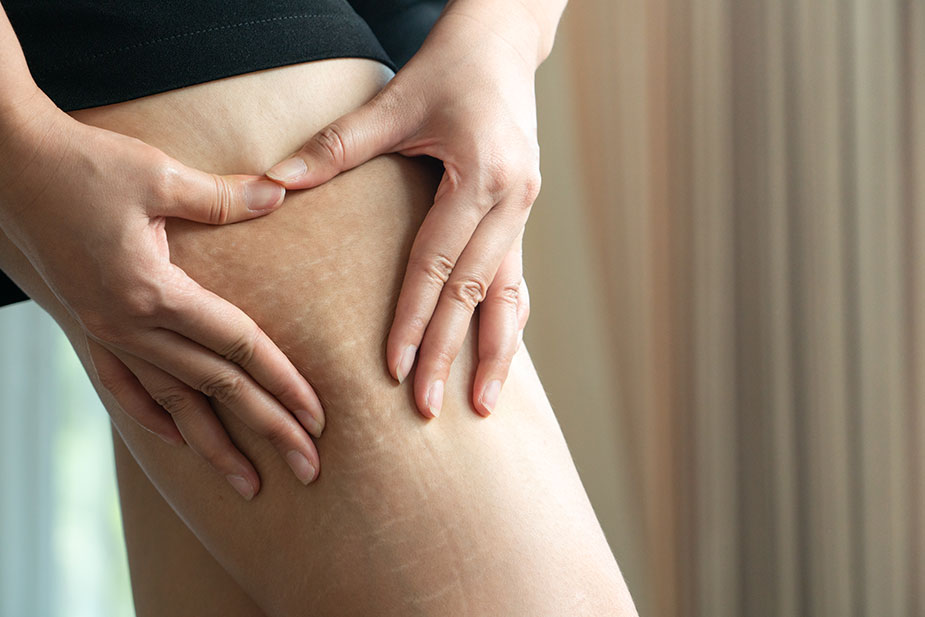Stretch marks (abb. SM) are areas of the skin where the deep dermis (middle layer of the skin) spontaneously tears during skin growth. They commonly appear during adolescence, pregnancy, or in the case of repeated diets. About 80% of women have SM, and most are frustrated because they resemble large scars, and treatments against them are not sufficiently effective.
It’s important to note that stretch marks are not a serious health problem, but rather an aesthetic one, and there are ways to at least partially alleviate them.
Stretch Marks on the Thighs
What are stretch marks and how do they form? The skin consists of three layers: the epidermis, dermis, and subcutaneous tissue. Each of these layers is composed of several sublayers. SM are areas of the skin where the deep dermis (middle layer) has torn. They are easily noticeable, and when they appear, they have a purplish-red color and are shaped like lines or streaks that resemble scars in length.
Over time, they fade and become white and pearly, almost the same color as the surrounding skin. Stretch marks occur during rapid physical development because the skin doesn’t have time to develop at the same pace as the body’s growth. They most commonly appear during pregnancy and puberty. They can also occur during significant and sudden weight gain or loss.
Where and how do stretch marks appear?
There are two phases in the evolution of these marks:
- Inflammatory phase, giving them a purplish-red appearance due to the dilation of blood vessels;
- Scarring phase, when they are white and atrophic. Stretch marks mainly appear on the abdomen and breasts (most often during pregnancy), arms, buttocks, and thighs.
In men, they are observed on the lower back, the inner side of the knees, and on the arms of those who exercise their arm muscles and increase muscle mass.

Diagnosis A dermatologist diagnoses stretch marks with a standard examination, as they are easily noticeable. The doctor determines the symptoms that led to their appearance. SM do not cause medical problems and rarely indicate a health issue that needs treatment.
Stretch Marks in Pregnancy
Stretch marks are a common occurrence during pregnancy, affecting about 90% of pregnant women. They usually appear during the second and third trimesters, on the abdomen, breasts, hips, thighs, and buttocks, as the skin in these areas stretches the most.
In some women, they can even develop in the armpits, lower back, and arms. After giving birth, the body is left with more or less noticeable traces of stretch marks.
Women with a genetic predisposition, those carrying a larger baby or twins, are more prone to the development of SM. Prevention during pregnancy doesn’t exist because the body develops rapidly, but applying stretch mark creams and regular physical activity can help make them less visible.

Stretch Marks on the Abdomen – An Aesthetic Problem of Today
Stretch marks in the abdominal area most commonly appear during puberty, rapid growth, or pregnancy. Due to this aesthetic issue, many women feel insecure and hide their bodies during summer. Some women, however, are not ashamed of this problem and comfortably enjoy the benefits of warm weather.
Regardless, if stretch marks bother you, it’s essential to dedicate yourself to their treatment to feel comfortable. Regular treatments can contribute to their noticeable reduction.
Treatment
The earlier stretch marks are treated, the better the results. It’s better to treat them during the inflammatory phase rather than the atrophic phase. In addition to creams, the most effective treatments are fractional radiofrequency, mesotherapy, and laser removal.
Several treatments are often required, and results vary depending on the individual and the severity of the SM. It’s important to note that no treatment can completely remove SM, but they can be significantly reduced and made less noticeable.
Prevention
While it’s impossible to completely prevent stretch marks, you can take some steps to minimize their appearance:
- Maintain a healthy lifestyle: Eat a balanced diet rich in vitamins and minerals (see diet advice bellow)
- Stay hydrated: Drinking enough water helps maintain skin elasticity, which may reduce the risk of SM.
- Use moisturizers: Regularly apply creams and lotions specifically designed for SM. They can help maintain skin elasticity and stimulate collagen production.
- Massage your skin: Gently massaging the areas prone to SM can improve blood circulation and promote skin elasticity.
- Avoid sun exposure: Excessive sun exposure can weaken the skin and make stretch marks more visible. Use sunscreen with a high SPF to protect your skin when outdoors.
Healthy diet against stretch marks
A healthy diet can play a role in preventing and reducing the appearance of SM. Here are some recommendations for a healthy diet:
- Stay Hydrated: Drinking plenty of water helps maintain skin elasticity, which can reduce the risk of developing SM. Aim for at least 8 glasses of water a day.
- Eat Foods Rich in Vitamins and Minerals: Consume foods high in vitamins A, C, D, and E, as well as minerals like zinc and silica, which are essential for skin health. Some examples include:
- Vitamin A: Carrots, sweet potatoes, spinach, and kale
- Vitamin C: Citrus fruits, strawberries, kiwi, and bell peppers
- Vitamin D: Fatty fish, eggs, and fortified dairy products
- Vitamin E: Nuts, seeds, avocado, and olive oil
- Zinc: Beef, poultry, beans, and nuts
- Silica: Whole grains, bananas, and green beans
- Include Healthy Fats: Incorporate healthy fats, such as omega-3 fatty acids, into your diet. These fats can improve skin elasticity and help prevent stretch marks. Sources of omega-3s include fatty fish (like salmon), walnuts, and flaxseeds.
- Consume Collagen-Rich Foods: Collagen is a protein that helps maintain skin elasticity. Foods rich in collagen or collagen-boosting nutrients include bone broth, chicken, fish, egg whites, and berries.
- Eat Enough Protein: Protein is essential for skin health, so make sure to include lean protein sources like chicken, turkey, fish, beans, and tofu in your diet.
- Maintain a Balanced Diet: Focus on consuming a variety of fruits, vegetables, whole grains, lean proteins, and healthy fats to ensure your body receives all the necessary nutrients. The Mediterranean diet is highly beneficial for these skin changes.
- Control Weight Gain: Rapid weight gain can lead to stretch marks, so try to maintain a steady, healthy weight by eating a balanced diet and engaging in regular physical activity.
Remember, while a healthy diet can help prevent and reduce the appearance of SM, it may not completely eliminate them. It is essential to combine a healthy diet with other lifestyle factors, such as exercise and skincare, to achieve the best results.
Conclusion
In conclusion, stretch marks are a common aesthetic issue that affects many people, especially women during pregnancy and periods of rapid growth. While there is no guaranteed way to prevent them, maintaining a healthy lifestyle, staying hydrated, and taking care of your skin can help reduce their appearance.
Various treatments are available to help minimize the visibility of SM, but remember that complete removal is unlikely. Consult with a dermatologist to determine the best course of action for your specific situation.
. . .
“Beauty is not in the face; beauty is a light in the heart.” – Kahlil Gibran
. . .




